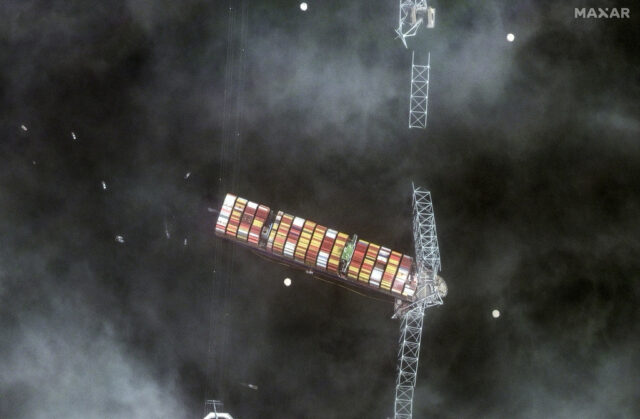BALTIMORE: It was the middle of the night when a dispatcher’s warning crackled over the radio: A massive cargo ship had lost its steering capabilities and was heading toward the Francis Scott Key Bridge. Within about 90 seconds, police officers responded that they had managed to stop vehicle traffic over the Baltimore bridge in both directions. One said he was about to drive onto the bridge to alert a construction crew. But it was too late. Powerless and laden with huge containers, the vessel smashed into a support pillar.
“The whole bridge just fell down,” a frantic officer said. “Start, start whoever, everybody… the whole bridge just collapsed.”
When the container ship Dali slammed into the pillar around 1:30 am Tuesday, it caused a long span of the Baltimore bridge, a major link in the region’s transport networks, to crash into the Patapsco River. The loss of the bridge is expected to snarl commuter traffic and disrupt a vital shipping port.
At least eight people went into the water. Two were rescued but the other six, part of a construction crew that had been filling potholes on the bridge, were missing and presumed dead. A search for their bodies was underway Wednesday morning, according to Maryland State Police spokesperson Elena Russo.
Among the missing were people from Guatemala, Honduras and Mexico, according to diplomats from those countries. The Honduran man was identified as Maynor Yassir Suazo Sandova.
Federal and state officials said the crash appeared to be an accident. The National Transportation Safety Board is investigating, and ship traffic entering and leaving the Port of Baltimore was suspended indefinitely.
Capt. Michael Burns Jr. of the Maritime Center for Responsible Energy said bringing a ship into or out of ports in restricted waters with limited room to manoeuvre is “one of the most technically challenging and demanding things that we do”.
“So there really is few things that are scarier than a loss of power in restricted waters,” he said. And when a ship loses propulsion and steering, “then it’s really at the mercy of the wind and the current”.
Video showed the ship moving at what Maryland Gov. Wes Moore said was about 9 mph (15 kph) toward the 1.6-mile (2.6-kilometre) bridge. Traffic was still moving across the span, and some vehicles appeared to escape with only seconds to spare. The crash caused the span to break and fall into the water within seconds, and jagged remnants were left jutting up from the water.
Police said there is no evidence anyone went into the water other than the workers, though they had not discounted the possibility.
A senior executive at the company that employed the crew, Brawner Builders, said they were working in the middle of the Baltimore bridge when it fell. “This was so completely unforeseen,” said Jeffrey Pritzker, the company’s executive vice president. “We don’t know what else to say. We take such great pride in safety, and we have cones and signs and lights and barriers and flaggers.”
The crash happened long before the busy morning commute on the bridge, which was used by 12 million vehicles last year.
Tuesday’s collapse is sure to create a logistical headache along the East Coast for months, if not longer, shutting down shipping traffic at the Port of Baltimore, a major hub.
With inputs from AP
















